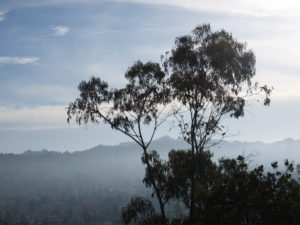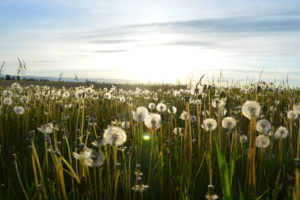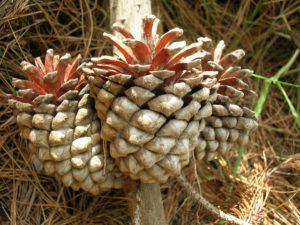For many years I’ve forgone a Christmas tree. Either I traveled to family for the holidays, or was put off by the trouble and expense of bringing holiday cheer to my household. Bah, humbug!
Last year with a new baby, I insisted on getting one, and so I delivered my family three blocks away to our local “sustainable” Christmas tree stand in San Francisco and we picked out the smallest, shapeliest one we could find. It was magical having a Christmas tree at home, and my son, Oliver, loved the lights and the stacks of presents he could topple over. I knew we were hooked.
As I pondered what we would do this year, an even better solution fell into my lap. The Pacifica Land Trust was hosting a “Charlie Brown Perfect” event that combined everything I could hope for in a Christmas tree. At Pedro Point Headlands, you could go out and cut down a Monterey pine and thereby help restore the land to native California coastal scrub habitat. Sign me up! If this wasn’t the most sustainable of Christmas trees, I don’t know what would be.
Pedro Point Headlands is a 246-acre park on Pacifica’s southern end that has been battling a Monterey pine expansion, a legacy of a motorcycle club that used to own the property that planted the trees for scenery and erosion control along the trails.
When the Pacifica Land Trust got its hands on Pedro Point in 1995, its chief aim was to restore the land to coastal scrub and prairie, habitats that are becoming increasingly rare along California’s coast. So the land trust started removing invasives, planting native flora and lessening erosion where it could.
Monterey pine and eucalyptus trees had been threatening to turn the land into forest. And so three years ago, the Pacifica Land Trust , which manages the property for the California Coastal Conservancy and the city of Pacifica, thought to make a holiday event out of removing some of the trees. One thing’s for sure: you have to be fairly open minded at what you count as a Christmas tree.
“They’re not pruned, they’re not perfect. They’re free-range trees,” said Lynn Adams, the stewardship coordinator for the Pacifica Land Trust, as we stood at the staging area.
Saw in hand, my husband, Tony, and I climbed up a hiking trail with Oliver in tow on our Charlie Brown tree adventure. Long story short, we chose a tree, checked out the zebra-striped San Pedro Rock, and then happened to run into Mike Vasey on the way back down. Vasey is an ecologist and board member of the Pacifica Land Trust, and he’d stationed himself along the side of the trail to warn people about the prolific, leafless poison oak stems that inundated a Monterey pine stand where tree-searchers might go a-wandering.
Vasey explained that the red flags on some of the trees indicated that they’d been selected to remain. Pacifica Land Trust wants to keep some of the Monterey pine stands, albeit under control, to ensure habitat for some 25 migratory songbirds and other species that have gotten used to the trees being there.
“We’re thinning the groves and allowing the groves to be sustained over time,” Vasey said.
Monterey pine, Pinus radiata, is native to the central California coast, which makes the restoration effort at San Pedro Headlands a bit of a twisty issue. It’s under threat in its limited native habitat in the Monterey peninsula, but a modern variety of Monterey pine has become the most widely planted species in the world for timber, and is considered an invasive in places like New Zealand.
As far as anyone knows, Monterey pine was never endemic to the San Pedro Headlands. But then again, Monterey pine fossils have been found dating back to more than 16,000 years ago at Mussel Rock, five miles north of Pedro Point, Vasey said. That makes the restoration question — whether to remove them or preserve them — particularly tricky.
“It’s a very dynamic system,” said Vasey. “You make judgements. But the idea is not to go back to some imaginary thing because things change.”
After lengthy internal debate, the Pacifica Land Trust decided to keep some of the Monterey pine with the idea to create a “mosaic” landscape of controlled pine forest and coastal scrub that could increase the area’s biodiversity.
And so in a small way, my family and the others who came to the Pacifica Land Trust’s event participated in this vision for Pedro Point. Yes, our tree is not perfect. But it’s a tree to remember.
[slideshow]
Alison Hawkes is the online editor of Bay Nature.





